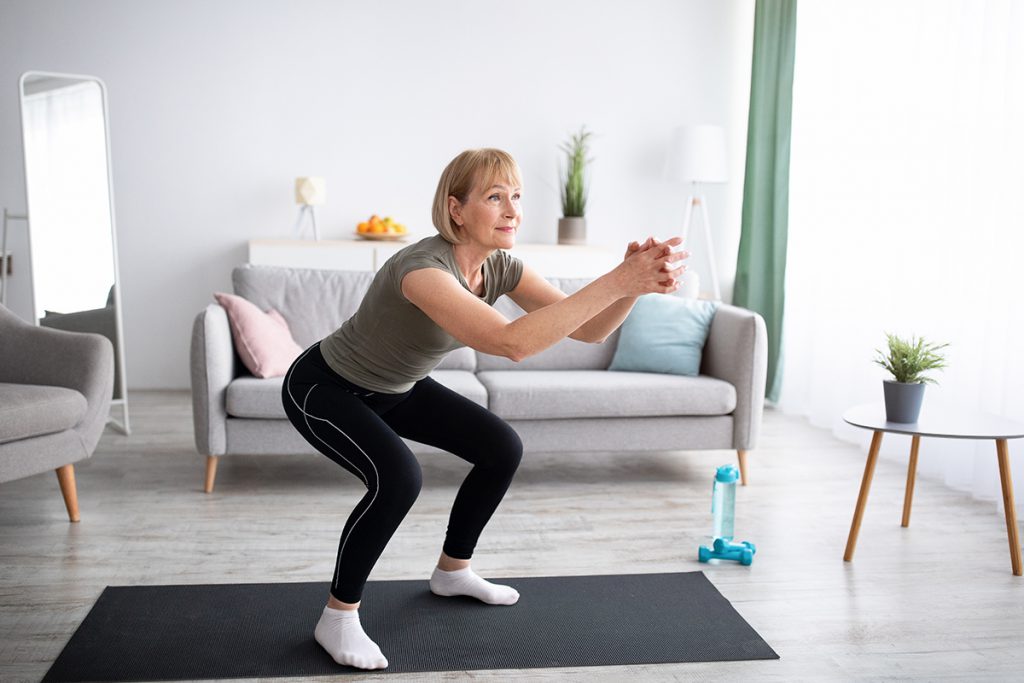The Best Strength-Training Workout for Beginners
Train your body to move better for years to come with these six functional exercises.

By now you probably know you should be strength training. It helps ward off age-related muscle loss, keeps your bones strong, promotes mobility, reduces risk of falls, and even combats depression. But knowing why you should do something doesn’t mean you know how to do it. And in the case of strength training, there’s real risk involved in just hitting the gym and throwing weights around.
A better plan: Start by learning a few functional strength exercises, suggests Phillip Higgins, D.P.T., clinical director at Bespoke Treatments Physical Therapy in Seattle. “The simplest definition of ‘functional’ is that the exercise, whether in the gym or at home, is a movement pattern that mimics some sort of daily activity,” he says.
Take squats, for example: They’re great for building and maintaining muscle strength in the lower body, but they also help you train for the act of lowering down to, and getting up from, the toilet without needing assistance, Higgins says. Functional training isn’t just about maintaining the strength and mobility to do daily activities with ease. You’ll also keep your nervous system primed to move in these ways, he adds. In other words, you’ll stay independent longer.
So should you just start doing squats every day? Not exactly. For best results, you need a well-rounded strength routine that incorporates multiple functional movements and can be scaled up or down depending on your current fitness level. “And the sooner you start doing it, the better,” Higgins says.
Lucky for you, we have exactly what you need to get started today. The functional workout below was designed to do two things:
- Eliminate the “I just don’t know what I should do” excuse for not strength training.
- Challenge every major muscle group with six basic, beginner-friendly movements — all of which closely resemble things you do in everyday life.
How to Do the Functional Strength Workout for Beginners
Start by doing one set of each exercise in order, using only your body weight or very light weights. As you get stronger, perform the full circuit up to three times, resting two minutes between rounds (more if you need it). You can also use the tips below to make any exercise harder.
Aim to do the full workout on two nonconsecutive days per week, adding a third or fourth day when you feel ready. Just remember to always give yourself a day to rest and recover between strength sessions.
Ready to get started? Here’s how to perform each movement. As always, safety is key. The exercises here may be different or more advanced than those you’ll experience in a SilverSneakers class. If you have a chronic condition (including osteoporosis) or an injury, talk to your doctor about how you can exercise safely.
Functional Exercise #1: Squat
Squats target the entire lower body, including your glutes, quads (front of your thighs), and hamstrings (back of your thighs). Every time you stand up from the couch, sit down at the dinner table, or pick something up off the floor, the squat movement pattern is in action.
Do 10 reps
How to do it: Stand tall with your feet about hip-width apart, toes pointing forward. Hold your arms straight out in front of you for balance.
From here, push your hips back and bend your knees to lower into a squat, keeping your chest up as you do. If you can, lower until your quads are parallel to the floor; if not, go as low as you comfortably can. Pause, then push through your heels to return to standing. That’s one rep. Do 10 reps, or as many as you can with good form.
Make it easier: If you’re struggling with balance or can’t seem to get very low in the squat, try a sit-to-stand exercise instead (also known as a chair stand or chair getup). See a video demonstration here.
Make it harder: Add weight by holding dumbbells, a medicine ball, or a kettlebell while you squat. You can also increase the time your muscles are under tension by taking three full counts to lower down, pausing at the bottom and then slowly pushing up.
Enjoying this workout? You’ll love the strength-and-cardio combo in SilverSneakers Circuit. It’s offered both in-person at participating SilverSneakers fitness locations, or online with SilverSneakers LIVE.
Functional Exercise #2: Seated Row with Resistance Band
The row is a pulling exercise — the same movement pattern you use to open a door — that helps improve your posture. It strengthens all the muscles in your upper back, as well as your shoulders, biceps, triceps, and even your core.
Bonus: Pulling exercises like the row are the antidote to activities that pull your shoulders and upper back forward, like hovering over a smartphone or tablet.
Do 10 reps
How to do it: Sit with your legs extended, heels touching the floor and toes pointing up. (If your hamstrings are tight, then a small bend in the knees or a pillow under the knees may help keep undue amounts of stress off the lower back, Higgins says.) Place the center of a resistance band behind the soles of your feet. If you’re using a long exercise band, you may need to loop it around your feet once or twice.
Hold the ends of the band with both hands, arms extended and palms facing each other. Sitting up tall, bend at the elbows and pull the band toward your torso, squeezing your shoulder blades together. Pause, then slowly return to the starting position. That’s one rep. Do 10 reps, or as many as you can with good form.
Make it easier: If you have difficulty getting down on the floor, try it in a chair. See a video demonstration here.
Make it harder: Perform a bent-over row holding dumbbells. See a video demonstration (along with three other row variations) here.
Functional Exercise #3: Step-up
This single-leg exercise helps train your body to safely step onto practically any surface, like a curb, and take the stairs in stride.
Do 10 reps
How to do it: Stand in front of a step with your arms at your sides. Start with a low step, increasing the height for a challenge.
Set your right foot (leading) on the step, push down through your heel, and lift yourself up until your right leg is straight. Bring your left foot (trailing) up to the step, and then step down one foot at a time. That’s one rep. Do 10 reps, or as many as you comfortably can, alternating the leading foot each time.
Make it easier: Do all reps with one foot (five) and then all reps on the other (five more). If you feel any discomfort in your knee, choose a shorter step and lean forward slightly as you perform the exercise.
Make it harder: Grab a pair of light dumbbells and hold them at your sides with palms facing your body as you perform the movement.
Functional Exercise #4: Wall Pushup
The pushup is popular for a reason: It strengthens just about everything, including your shoulders, triceps, chest, core, and even your glutes (if you squeeze them during the movement). It also trains the pushing movement pattern, which comes in handy when you’re pushing yourself up off the ground, putting something heavy away on the top shelf, or lifting your suitcase into the overhead compartment.
Do 10 reps
How to do it: Stand facing the wall with your feet hip-width apart and knees slightly bent. Place your palms slightly wider than shoulder-width apart on the wall. Bend your elbows and lower your upper body toward the wall, keeping your core tight so your body stays in a line (no dipping in your back). Pause, and then press back to the starting position. That’s one rep. Do 10 reps, or as many as you can with good form.
Make it easier: Take a step toward the wall. The more upright your body is, the easier it will be.
Subscribe to our newsletter
It's quick and easy. You could be one of the 13 million people who are eligible.
Already a member? Click to discover our 15,000+ participating locations.
Follow Us
Make it harder: Take a step back so you have to push more body weight away from the wall. Still too easy? Reduce the incline by doing pushups with your hands on a countertop or bench, and then eventually do standard pushups on the floor.
Functional Exercise #5: Standing Hip Abduction
Lifting your leg out to the side — called abduction — targets the small muscles on the outsides of your glutes, which are important for being able to move side to side with ease.
Do 10 reps on each leg
How to do it: Stand tall facing a wall, kitchen counter, or back of a sturdy chair, holding on to it for balance. Keeping your back straight, engage your core and allow both knees to bend slightly.
From here, lift one leg out to your side as far as you comfortably can, making sure not to tilt your trunk as you do so. Pause, then slowly lower your leg to return to starting position. That’s one rep. Complete 10 reps, and then repeat with your opposite leg.
Make it easier: Try a side-lying leg lift instead. Lie on one side, with your legs extended and hips stacked. Support your head with your bottom arm, and place your top arm on the floor directly in front of your torso for support. Keeping your heel slightly behind your body and your toes pointing forward, slowly raise your top leg as high as you can. Pause, then return to starting position.
Make it harder: Perform the abductions with a small resistance band looped around your legs, just above your knees.
Functional Exercise #6: Farmer’s Carry
A carry exercise is exactly that: It gets you comfortable lifting, carrying, and holding heavy things, like your grocery bags, with good form. How does it do that? By helping you develop strength in your core, arms, and hands, among other benefits.
Higgins calls this exercise “expert level” when you use heavy weights, so start by holding a light weight in each hand and increase the load only when you feel ready.
Walk for 30 seconds
How to do it: Grab a pair of weights (kettlebells or dumbbells), and let them hang naturally at arm’s length next to your sides, palms facing in. Walk forward for as long as you can (aim for 30 seconds), keeping an upright torso and not allowing the weight to dump into your low back. Imagine a string is connected to the top of your head and pulling you toward the ceiling.
If you can walk for longer than 60 seconds, try using a heavier weight.
Make it easier: Start with marching in place. Stand tall, and lift one knee as high as you can, aiming to get your thigh parallel to the floor. Return your foot to the floor and immediately lift the other knee so that you’re marching in place. Continue marching for 30 seconds.
Make it harder: Introduce more weight. Doing so will increase the load placed not only on your core, back, and glutes, but also on your hands. When using challenging weights, the farmer’s walk becomes a great way to improve grip strength.
Take Your Favorite SilverSneakers Classes Online!
SilverSneakers members can access live fitness classes and wellness workshops through SilverSneakers LIVE. See the latest schedule and RSVP for classes here.
Not a member? If you have a Medicare plan, it may include SilverSneakers — at no additional cost. Check your eligibility instantly here.





